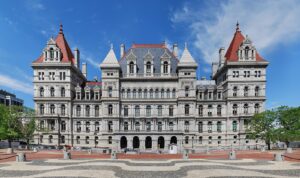The US economy is giving off weird vibes right now.
There are millions of job openings and the unemployment rate is low. In fact, it hasn’t been this low for such a long stretch of time in decades. You’d think that would mean the economy is coasting, since periods of low unemployment are generally associated with higher rates of economic prosperity.
But there’s a slew of red flags right now — like a large and growing share of people, particularly Gen Zers, taking on such high levels of credit card debt to cover their spending that lenders have stopped loaning more money to them.
That seems to be the case with a lot of recent economic data: No piece of good news comes without other evidence that give economists pause. “I wouldn’t give the economy a clean bill of health,” said Gregory Daco, chief economist at EY. “It looks robust, but there are pockets of concern.”
But while the state of the economy has economists weighing their words, presidential candidates see it in more binary terms. For instance, President Joe Biden tells voters the economy is booming and has hardly ever been doing better — even though, as he frequently says, there’s still work to be done. Yet from former President Donald Trump’s vantage point, “the economy is crashing” and is in total disarray, he said at a recent campaign rally in Wisconsin.
Here’s what’s really going on.
If you’re already optimistic about the economy’s current state, you’re going to feel even better by parsing through some of the latest labor market data.
Currently, there are 8.5 million job openings. That exceeds the number of pre-pandemic job openings by 1.5 million. Meanwhile, there are 6.5 million unemployed people. That means there’s more than one job per job seeker. In the decade preceding the pandemic, that ratio was 0.6 on average, signifying there were more job seekers than the number of job openings.
Americans’ average hourly earnings are 22% higher than before the pandemic, according to Bureau of Labor Statistics data. Though wage increases have been slowing, they’re rising at a faster rate than prices.
That’s good news for consumers, since it means their income is stretching further.
Though inflation has cooled significantly from its peak in the summer of 2022, further progress toward the Federal Reserve’s 2% target is looking like it’ll be a lengthy process.
That trajectory has taken many Fed officials by surprise, including Gov. Christopher Waller who thought the economy would be in a good position for cutting interest rates by now. “However, the first three months of 2024 threw cold water on that outlook, as data on both inflation and economic activity came in much hotter than anticipated,” Waller said in a speech Tuesday.
But he said April Consumer Price Index data, which showed headline inflation levels cooled slightly, was “welcome relief.”
“If I were still a professor and had to assign a grade to this inflation report, it would be a C+— far from failing but not stellar either,” he added.
But at the same time, consumers believe that inflation will move higher in the year ahead, according to two surveys Fed officials monitor closely.
Since inflation expectations can effectively control the pace of price hikes, businesses take those expectations into account when pricing goods and services. That can lead to higher prices.
However, an early reading on retail spending for April came in much weaker than expected as consumers reined in their spending. That’s good in the sense that it doesn’t give retailers the ability to pass along higher prices to consumers if they aren’t willing to accept them, which had previously been the case. But given consumer spending is one of the biggest drivers of the economy, a pullback can have adverse effects, too.
“It certainly bears watching, but part of the weakness probably was ‘payback’ for strength in prior months,” David Alcaly, lead macroeconomic strategist at Lazard, told CNN.
Daco said he sees the retail sales report as a sign that consumers are “a little more cautious, but are not retrenching.” However, if spending starts to slow a lot more, that could negatively impact the economy, he said.
The biggest flashing red light in the economy right now is the level of debt people are racking up.
One reason consumer spending has held up so well in the face of higher-than-desirable inflation combined with the highest interest rates in over two decades is that consumers aren’t necessarily spending within their means.
The savings many accumulated during the pandemic have all but evaporated, leading to a lot more credit card purchases that aren’t being paid back on time.
That, combined with the gradually cooling labor market — which is reducing workers’ leverage — is causing some households to accumulate more debt and fall into serious delinquency, meaning 90+ days late on a payment.
Recent New York Fed data showed the percentage of credit card balances in serious delinquency climbed to its highest level since 2012.
“The rising levels of consumer debt and delinquency rates, if continued, are not just individual problems; they could have macroeconomic effects requiring attention from economic policymakers,” Sung Won Sohn, a Loyola Marymount University economics and finance professor and chief economist of SS Economics, wrote in a recent note. “As more income is directed toward debt repayment, consumers have less disposable income for other purchases.”
The rising delinquencies will likely force banks and other lenders to lend less money to borrowers deemed riskier or cause lenders to charge even higher interest rates, he said. Ultimately, these combined effects “can contribute to a broader economic slowdown — or even a recession.”
Read the full article here











